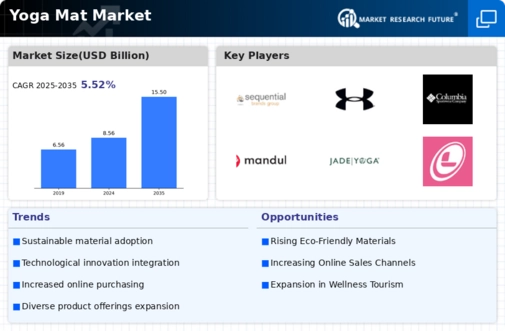Yoga Mat Size
Yoga Mat Market Growth Projections and Opportunities
The yoga mat market operates within a dynamic environment influenced by factors such as the growing popularity of yoga and fitness activities, consumer preferences, and technological advancements. Yoga mats, essential for providing cushioning and grip during yoga practice, have become a staple accessory for millions of yoga enthusiasts worldwide.
Consumer preferences play a significant role in shaping the dynamics of the yoga mat market. As individuals increasingly prioritize health and wellness, there has been a surge in demand for yoga mats that offer comfort, durability, and eco-friendliness. Consumers are seeking mats that provide adequate support for their joints and stability during poses, while also being easy to clean and environmentally sustainable. Additionally, as yoga continues to evolve and diversify with various styles and practices, there is a growing demand for specialized mats designed to cater to specific needs, such as hot yoga, Pilates, or meditation.
Technological advancements have also contributed to the growth of the yoga mat market, leading to the development of innovative materials and construction techniques. Traditional yoga mats were typically made from PVC (polyvinyl chloride), but concerns about environmental sustainability and chemical exposure have prompted manufacturers to explore alternative materials such as natural rubber, TPE (thermoplastic elastomer), cork, and organic cotton. These materials offer superior grip, durability, and biodegradability, providing consumers with more options to choose from based on their preferences and values.
Furthermore, changing lifestyle trends and the rise of social media influence the dynamics of the yoga mat market. As yoga gains popularity as a form of exercise and mindfulness practice, consumers are increasingly seeking products that reflect their personal style and identity. Vibrant colors, patterns, and designs have become popular features of yoga mats, allowing users to express themselves and stand out in a crowded market. Additionally, the rise of yoga influencers and social media platforms has fueled demand for aesthetically pleasing and Instagram-worthy yoga mats that are not only functional but also visually appealing.
Market competition within the yoga mat industry is intense, with numerous brands and manufacturers vying for market share. Brands differentiate themselves through product innovation, quality, pricing, and marketing strategies. Established yoga and fitness brands compete alongside niche players and startups offering unique features and designs to attract consumers. Additionally, partnerships with yoga instructors, wellness influencers, and celebrities help brands to build credibility and reach a wider audience.
Moreover, economic factors such as disposable income levels and consumer spending behavior influence the dynamics of the yoga mat market. While some consumers may prioritize affordability and opt for budget-friendly mats, others may be willing to invest in higher-priced options made from premium materials and offering advanced features. Additionally, the rise of e-commerce and online retail has expanded the reach of yoga mats, allowing consumers to browse and purchase products from the comfort of their homes and access a wider selection of brands and designs.
In conclusion, the yoga mat market is characterized by dynamic forces driven by changing lifestyle trends, consumer preferences, technological advancements, and market competition. As the demand for yoga mats continues to grow, companies must stay agile and innovative to meet the evolving needs of consumers. By understanding and leveraging these market dynamics, businesses can capitalize on the popularity of yoga and contribute to the growth and diversification of the yoga industry.










Leave a Comment